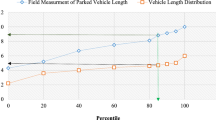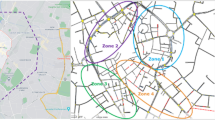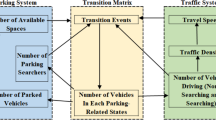Abstract
Illegal parking, particularly in urban areas, can cause severe delays and contribute significantly to traffic congestion. The main objective of the present work is to assess, using microsimulation modeling, the impacts of the phenomenon of double parking along an urban axis. A case study of an urban axis of the city of Thessaloniki, that daily serves heavy traffic, with a dedicated bus lane, is presented. Two different scenarios are modelled; one where only legal on-street parking along the axis is considered and a second one, representing the actual situation, where also a number of double-parking events are modelled; and the interaction with the traffic the axis serves is studied. Data on vehicle speed, average travel time, delay and stopped time are compared and the results show that all traffic indicators are affected by the phenomenon of double parking. Additionally, energy consumption and emissions of air pollutants are also compared to assess the impacts of double parking on the environment. The findings assist in quantifying the impacts of double parking, highlighting the importance of enforcement and measures aimed at reducing and eventually eliminating illegal parking, in order to improve traffic conditions and the quality of the atmosphere along the axis and consequently upgrade the quality of life of its residents, employers and travelers.
Access provided by Autonomous University of Puebla. Download conference paper PDF
Similar content being viewed by others
Keywords
1 Introduction
In an urban network, illegal parking can have several major negative impacts such as traffic congestion with increased delays and travel times, unnecessary fuel consumption and increased resulting emissions, decrease of the quality of bus services, even increase of the possibility for an accident. Furthermore, illegal parking contributes in the aesthetic and environmental degradation of urban areas, making them less attractive for both vehicles and pedestrians.
Double parking is a type of illegal parking that many cities suffer from, caused either by private vehicles, stopping for a while so that passengers can serve personal activities, or freight vehicles, stopping for loading and unloading purposes.
Several case studies have been examined by researchers in order to evaluate the impacts of illegal parking but only a few of them concentrate on illegal double parking using a modelling approach. In 2007, Lu and Viegas analyzed how illegal double parking influences traffic flow and studied its impacts in an area of Lisbon using VISSIM software. Also in 2007 Galatioto and Bell simulated, using DRACULA framework, illegal double parking in a high-density area of Palermo, Italy, showing its significant negative impacts in traffic, in terms of length of queues, capacity, and the environment, in terms of vehicle emissions. Later, in 2013, Kladeftiras and Antoniou studied, using TransModeler microsimulation software, the traffic and environmental impacts the reduction or even elimination of illegal double parking phenomenon would have in the city of Athens, Greece. Gao and Ozbay, in 2015, used a M/M/∞ queueing model and developed a microsimulation model in Paramics to estimate double parking impact on traffic in case studies in Midtown Manhattan and Downtown Brooklyn.
The present paper also uses a microsimulation traffic model to study the phenomenon of double parking along an axis of the city of Thessaloniki, Greece in order to examine the impacts it has in traffic, energy consumption and emissions. The paper is structured as follows. After this introductory part, the methodology that has been followed for the assessment of illegal double parking impact is presented, Sect. 3 presents the case that is studied from the city of Thessaloniki, Sect. 4 the results of the case study and the last section concludes the paper.
2 Methodology
The methodology of this research is based on the set-up, calibration and validation of a micro-simulation model reflecting the traffic conditions along an urban road axis. In order to explore the effects of illegal double parking along the axis, two simulation scenarios were examined:
Scenario 1:
Current situation where illegal double parking that has been recorded has been simulated.
Scenario 2:
An ‘ideal’ situation where there is complete compliance with the existing parking regulations.
In more detail, the methodological approach followed included:
-
Data collection about illegal parking along the axis (time of day, location, duration).
-
Set-up of a micro-simulation traffic model in AIMSUN software with detailed information about the road geometry (number/width of lanes, bus lanes, bus stop locations, traffic control, turning movements, etc.), public bus transport, traffic demand and traffic composition.
-
Introduction of an approach to model in AIMSUN locations and duration of double parking phenomenon using reserved lanes plus incidents to model the burden that is caused to adjacent lanes for as long as parking maneuvers take place.
-
Calibration of the model parameters to reflect the actual drivers’ behavior.
-
Evaluation of the outputs, making a comparison between the scenarios and assessing the impacts of the phenomenon through 4 traffic and 5 energy/environmental indicators (travel time, mean speed, stop time, delay time, fuel consumption, CO2 emissions and NOx, VOC, PM emissions).
3 Case Study
The present paper chooses to study the phenomenon of on-street illegal, double parking on an urban axis in the city of Thessaloniki, Greece.
It is a major axis with a total length of 6,2 km that daily serves heavy traffic, with direction from the east to the west of the city. It is a one-way road with 4 lanes, one of them being used as a dedicated bus lane. The axis is one of the most important of the city connecting its southeastern areas with the city center.
At the same time, it is an important commercial axis of the city, with a large number of businesses and stores located along it. Hence, it acts as a pole of attraction from adjacent areas and, in conjunction with the high density residential area located alongside, serves the needs of large numbers of people living and being active on it.
As a result there is high parking demand along the axis that is however not served by the available legal on street parking offer and this combined with the absolute lack of enforcement in the area are causing an intense phenomenon of illegal parking and double parking.
The average daily traffic of the axis is estimated at 35.000 vehicles. The peak is observed during the morning period, and in particular from 08:00 to 09:00, during which more than 11.000 journeys are served by the axis (Mitsakis et al. 2013). Of these, 523 movements (4,8% of the total) carry out a through movement along the whole axis.
A parking characteristics survey that took place in 2013 to support the planning of a controlled parking system in the Municipality of Thessaloniki (Aifantopoulou et al. 2013) - that has not been implemented in the area yet- recorded along the axis 128 parking spaces. 63% of the vehicles recorded by the survey were illegally parked, with 49% of them being double parked, and parking deficit was calculated at 854 car parks per day (Fig. 1).
The present work studies the phenomenon of on-street illegal, double parking on the axis for the typical weekday morning peak period, 08:00–09:00.
Based on the methodology described above:
Illegal double parking along the axis was quantified, in terms of location and duration. Detailed on-site observations were held in order to identify the locations where the phenomenon of illegal double parking appears. Additionally, and in order to determine how long double parking events last, data from the detailed recording of legal and illegal parking along the axis that took place in the framework of the 2013 parking characteristics survey were used.
A microsimulation traffic model was set-up in AIMSUN (Advanced Interactive Microscopic Simulator for Urban and Non-Urban Networks). (Dynamic Route Assignment Combining User Learning And microsimulation) a software of TSS (Transport Simulation Systems) company that allows mesoscopic, microscopic and hybrid simulation.
The representation of the road axis in AIMSUN software environment consists of 379 road sections, 86 intersections, 31 of which are signalized and includes information about road direction, number, width and functional use of lanes, capacity, maximum permitted speed, slope, type of vehicles using the road, bus stops locations, on street parking locations, nodes geometry allowed turns, signage, traffic control, pedestrians’ crossings, and traffic signals timing.
Information about the 9 bus lines of public transport serving the axis was also included in the model. For each bus line, information about the road sections that it runs, the bus stops where it stops, the detailed timetable for the peak hour and the average bus stop duration was included.
Traffic demand was taken from the macroscopic traffic model of the metropolitan area of Thessaloniki that has been developed by the Hellenic Institute of Transport (Stamos et al. 2011). The data refer to the morning peak hour (8:00–9:00) and was given in 6 Origin/Destination matrixes, for the 6 different types of vehicles using the road (cars, taxis, motorbikes, buses, trucks and public transport buses) and used 92 centroid locations to allocate the demand on the network.
To simulate double parking, ‘incidents’ were used to specify where, when and how long double parking events along the axis occur based on the results of the data collection. In addition, extra ‘incidents’ were inserted to model the burden caused to adjacent lanes, that includes time for identifying a sufficient gap between already parked vehicles, the vehicle speed reduction and the necessary maneuvers to park. A time of 15 s (±5 s) was considered as the mean time a driver needs for this procedure.
Figure 2 presents the two simulation scenarios that were set-up, without and with illegal double parking events along the axis.
The model was then calibrated to represent the traffic conditions as accurately as possible. Data from traffic counts in 8 nodes and 2 sections along the axis were used for this purpose as well as data about average speed and travel time of taxis and public transport buses along the axis taken from their fleet monitoring centers. Comparing this actual data with simulation outputs, the model was calibrated and the figures below (Fig. 3) compare the measured vs the simulated values.
The simulation time was set at 1 h, recording data every 15 min, that is standard time period use according to Roess et al. and 5 replications of each scenario were performed according to the software guidelines (AIMSUN 2017). For the estimation of the environmental/energy indicators, the integrated in AIMSUN software microscopic emission model, (Panis et al. 2006) has been used that relates vehicle emissions with the instantaneous speed and acceleration of the vehicle (Fig. 5).
4 Results
After the calibration and the validation of the traffic model and considering it as reliable, the two scenarios were tested in order to estimate the impacts of illegal double parking on traffic conditions of the axis, as well as the consequences on the environment.
The results of the traffic indicators (Fig. 3) show that all are heavily affected by the phenomenon of illegal double parking. More specifically, average speed of private cars is reduced by about 18 km/h, dropping from 45 to 26 km/h, average speed of taxis by 16 km/h, of public transport buses by 6 km/h, dropping to 15 km/h, and of other commercial vehicles by 14–16 km/h leading to an increase of travel time of about 10 min for private cars and motorbikes, 7 and 10 min for taxis and public transport buses respectively and 10 min for commercial vehicles. Consequently, delay time and stopped time increase for all vehicles.
The effects of illegal double parking are also assessed in terms of fuel consumption and emissions (Fig. 4). The fuel consumption indicator represents the total fuel, in liters, that all vehicles consume during the simulation time. The results show an increase of 50% on fuel consumption with the existence of illegal double parking. Regarding the emissions and more specifically carbon dioxide (CO2), oxides of nitrogen (NOx), volatile organic compounds (VOC) and particulate matter (PM) a significant increase is also observed in the illegal double parking scenario of about 500–900%, depending on the emission type since the instantaneous speed and acceleration of the vehicle are severely affected (Fig. 5).
5 Conclusions
The present paper analyzes the important impact of illegal double parking along an urban axis, during peak hour, not only in traffic but also in the environmental conditions. The results indicate a significant decrease of travel speed for all vehicle types using the axis and a resulting increase in travel and delay time resulting in lost productivity time of travelers. The performance of public transport bus lines is affected, with unreliable timetables and increased delay times, resulting in public transport unattractiveness.
The results make apparent that eliminating illegal double parking in the axis would result in tremendous improvement of traffic conditions as well as in the important reduction of fuel/energy consumption and the improvement of quality of the atmosphere along the axis and they quantify the benefits that would arise from a potential limitation. Therefore, the importance of enforcement and measures aimed at reducing and eventually eliminating illegal double parking by the responsible authorities is highlighted, in order to upgrade the quality of life of the areas’ residents, employers and travelers.
References
AIMSUN Version 8.2 User’s Manual, TSS-Transport Simulation Systems (2017)
Aifadopoulou, G., Morfoulaki, M., Kotoula, K.M.: Deliverable D5: Implementation Study of Thessaloniki’s Controlled Parking System, in the framework of “Technical consulting services to the Municipality of Thessaloniki for the preparation of Technical Specifications for the suggested parking control system”, February 2013
Galatioto, F., Bell, M.C.: Simulation of illegal double parking: quantifying the traffic and pollutant impacts. In: 4th International SIIV Congress, Palermo, Italy (2007)
Gao, J., Ozbay, K.: Modeling double parking impacts on urban street. In: 95th Annual Meeting of the Transportation Research Board (TRB), Washington, D.C., USA (2016)
Kladeftiras, M., Antoniou, C.: Simulation-based assessment of double-parking impacts on traffic and environmental conditions. Transp. Res. Rec. J. Transp. Res. Board 2390, 121–130 (2013)
Lu, B., Viegas, J.: The analysis of the influence of the double parking vehicles to the central traffic flow. In: International Conference on Transportation Engineering (ICTE), pp. 3121–3126 (2007)
Mitsakis, E., Stamos, I., Salanova, J.M., Chrysochoou, E., Iordanopoulos, P., Aifadopoulou, G.: Urban mobility indicators for Thessaloniki. JTLE 1, 148–152 (2013)
Panis, L.I., Broekx, S., Liu, R.: Modelling instantaneous traffic emission and the influence of traffic speed limits. Sci. Total Environ. 371, 270–285 (2006)
Roess, R.P., Prassas, E.S., McShane, W.R.: Traffic Engineering, 4th edn. Pearson, Upper saddle River (2010)
Stamos, I., Salanova, J.M., Mitsakis, E., Aifadopoulou, G.: Large scale dynamic traffic assignment model for real-time traveler information services. In: ITS 2011, Patras, Greece (2011)
Acknowledgement
The present work has been implemented in the framework of the co-financed by the European Regional Development Fund project REMEDIO «Regenerating mixed – use MED urban communities congested by traffic through innovative low carbon solutions» of the Interreg MED programme.
Author information
Authors and Affiliations
Corresponding author
Editor information
Editors and Affiliations
Rights and permissions
Copyright information
© 2019 Springer Nature Switzerland AG
About this paper
Cite this paper
Chrysostomou, K., Petrou, A., Aifadopoulou, G., Morfoulaki, M. (2019). Microsimulation Modelling of the Impacts of Double-Parking Along an Urban Axis. In: Nathanail, E., Karakikes, I. (eds) Data Analytics: Paving the Way to Sustainable Urban Mobility. CSUM 2018. Advances in Intelligent Systems and Computing, vol 879. Springer, Cham. https://doi.org/10.1007/978-3-030-02305-8_20
Download citation
DOI: https://doi.org/10.1007/978-3-030-02305-8_20
Published:
Publisher Name: Springer, Cham
Print ISBN: 978-3-030-02304-1
Online ISBN: 978-3-030-02305-8
eBook Packages: EngineeringEngineering (R0)









